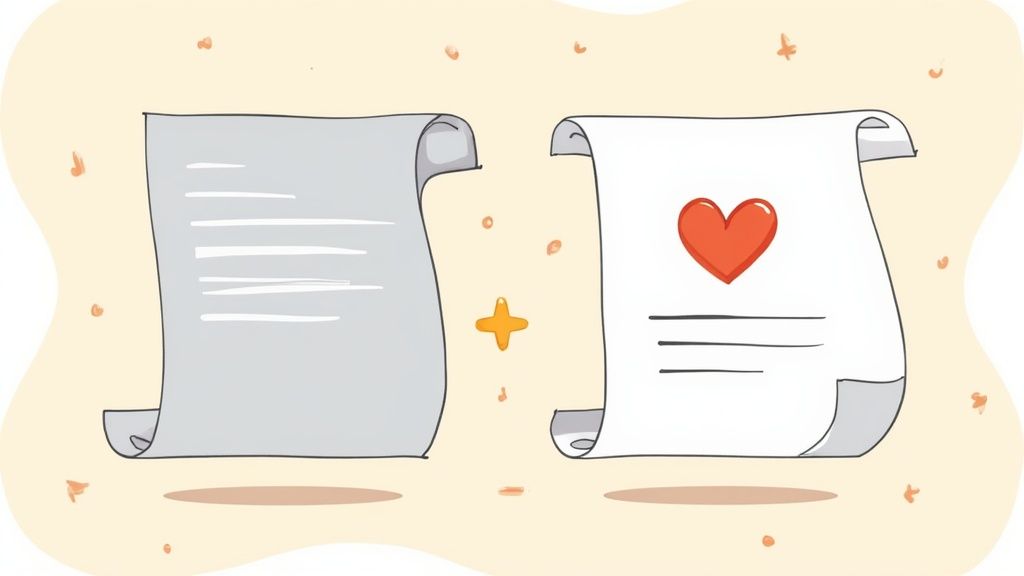How to Find Your Writing Voice and Sound Authentic
Tired of writing that doesn't sound like you? Learn how to find your writing voice with this guide full of real advice and practical exercises.

Finding your writing voice is all about letting your unique personality, perspective, and style show up on the page. It's what turns a generic manual into a passionate letter from a friend. This is achieved by weaving together your authentic tone, rhythm, and word choice to create a genuine connection with your readers.
What a Writing Voice Actually Is and Why It Matters

Let's be honest, the term "writing voice" can sound like some vague, artsy concept reserved for famous novelists. In reality, it’s one of the most practical tools in your toolkit. It’s the invisible thread that connects you to your audience, turning passive readers into a loyal community. It's about being human, not just a content machine.
Think of it as the unique flavor you bring to your words. It’s not just what you say, but how you say it. A strong voice, built from the vocabulary you use and the rhythm of your sentences, makes your content instantly recognizable and builds trust ethically.
The Core Components of Your Voice
To really get a handle on your writing voice, you first need to know what it’s made of. It’s a blend of a few key elements that work together to create a distinct personality on the page. These aren't complicated theories; they're simple, powerful ingredients you already use every day.
- Tone: This is the attitude behind your words. Are you witty and sarcastic? Empathetic and nurturing? Maybe you're authoritative and direct. Your tone sets the emotional stage for your reader.
- Style and Diction: This boils down to your word choice and sentence structure. Do you prefer simple, direct language or more descriptive, complex sentences? Do you use industry jargon or break things down into plain English?
- Rhythm and Cadence: This is the flow and pacing of your writing. Short, punchy sentences create urgency. Longer, more flowing sentences can feel thoughtful and calm. The mix is what creates your unique cadence.
- Perspective: This is your unique point of view, shaped by your experiences, values, and beliefs. It's the "you" in your writing that absolutely no one else can replicate. It’s your most ethical asset.
Your writing voice isn’t something you find hiding under a rock; it's something you uncover and refine. It's already there in the way you talk to friends, explain your passions, and tell stories. The trick is learning to translate that authenticity onto the page.
A well-defined voice builds a powerful connection. When readers feel like they know the person behind the words, they're far more likely to trust your message, engage with your content, and keep coming back for more. It's what separates memorable content from forgettable noise.
Discover Your Voice by Ditching the Inner Critic

Here's a little secret: your most authentic voice isn't lost. It’s just buried.
It’s trapped under layers of self-doubt, the pressure to sound "professional," and that nagging little critic on your shoulder questioning every single word you type. This constant self-censorship is the single biggest wall between you and writing that sounds like you.
The fastest way I know to tear down that wall is freewriting. It’s a dead-simple technique—and completely free—designed to get your unfiltered thoughts onto the page before your brain has a chance to sanitize them. Think of it as creating a judgment-free zone for your words.
The process is refreshingly simple. You set a timer for a short burst—say, 10 minutes—and you just write. There are no rules about grammar, spelling, or even making sense. The only rule is you can't stop until the timer goes off.
Your First Freewriting Session
Ready to give it a shot? Remember, this isn't about producing a polished draft. It's about capturing raw material. It’s an honest conversation with yourself, committed to the page.
Here’s a practical way to get started:
- Set a Timer: Pop open a blank document and set a timer for 10 minutes. The short duration is key—it lowers the stakes.
- Pick a Simple Prompt: Choose something you can talk about easily. Don't overthink this part.
- Just Write: Start typing and don't stop. If you get stuck, literally write "I don't know what to write" until a new thought pops in. Don't edit, don't backspace, and don't second-guess a single word.
Need a prompt to kick things off? Try one of these:
- Describe something you're passionate about to a close friend.
- Explain a complex topic you know well in the simplest terms you can.
- Write about a minor, silly frustration from your day.
This exercise forces you to bypass the part of your brain obsessed with perfection. The goal isn’t to create something for an audience; it’s to create something for you. This is the foundational step in learning how to find your writing voice in its most natural state.
Freewriting is like stretching before a workout. It loosens up your creative muscles and gets you into a state of flow, silencing the critic that makes your writing feel stiff and unnatural.
Reviewing Your Raw Notes
Once the timer dings, walk away for a few minutes. When you come back, read what you wrote. But don't look for mistakes—look for patterns. This is where you'll find the clues to your real voice.
As you scan your freewriting, ask yourself:
- What words or phrases do I repeat? These are your go-to expressions, your verbal tics.
- What's the natural rhythm of my sentences? Are they long and flowing, or short and punchy?
- What kind of energy comes through? Is it funny, intense, thoughtful, or analytical?
This raw text is a goldmine. It shows you what you sound like when you stop trying so hard. You’ll start to spot your unique cadence, your preferred vocabulary, and the genuine personality that shines through when you finally let go of the pressure to be perfect.
Learn From Writers You Admire Without Copying Them
Finding your voice doesn't happen in a vacuum. Think about it: musicians learn by playing songs they love, and painters study the masters. Writers are no different. We develop our own style by getting under the hood of the work we admire most.
This isn't about imitation. It’s about deconstruction. The ethical approach is to learn from techniques, not to plagiarize ideas.
The goal is to pinpoint the exact techniques other writers use to create their magic. By breaking their style down into tangible parts, you build a toolkit of new skills to experiment with. This is how you learn how to find your writing voice on purpose, not by accident.
Become an Active Reader, Not a Passive One
There’s reading for pleasure, and then there’s reading for craft. When you’re reading to learn, you can’t just let the words wash over you. Your job is to figure out how the writer is making you feel a certain way.
Start by picking two or three writers whose work just clicks with you. They could be bloggers, novelists, journalists—it doesn't matter. What matters is that their voice grabs you and makes you think, "Damn, I wish I could write like that."
Got them? Good. Now, grab a piece of their work you love. It's time to dissect it.
A Checklist for Deconstructing Style
As you read, look for patterns in a few key areas. You’re not trying to find a secret formula, but to identify the specific building blocks they use to construct their voice.
- Sentence Structure: Are their sentences long and flowing, or short and punchy? Notice how they mix up the length to create a certain rhythm. A string of short sentences can build tension, while a long, meandering one can feel more thoughtful or reflective.
- Word Choice (Diction): What kind of words do they reach for? Is the language simple and direct? Academic and complex? Do they lean on slang, humor, or sharp, descriptive adjectives? Make a note of specific words that jump out at you.
- Tone and Attitude: How would you describe their personality on the page? Are they cynical? Enthusiastic? Warm and approachable? The tone is the emotional current running beneath the words, and it's often what creates that deep connection with readers.
- Unique Perspective: What angle are they coming from? They aren't just dumping information; they're filtering it through their own experiences, beliefs, and worldview. How does that unique lens shape their arguments and stories?
Learning from other writers is like being an apprentice to a master craftsperson. You watch their hands, study their tools, and try to understand the thinking behind each choice. You're not stealing their final product; you're learning their process.
This kind of deep analysis transforms you from a simple consumer of content into a student of the craft.
For instance, you might notice one writer constantly uses rhetorical questions to pull the reader in, while another uses witty analogies to break down complex topics. These aren't vague feelings; they are specific, learnable techniques.
Once you’ve identified these elements, the real work begins: experimentation.
Try writing a paragraph using short, direct sentences like one of your favorite authors. See how it feels. In your next piece, try weaving in a clever metaphor in the style of another.
This process of borrowing, adapting, and blending is how you eventually discover what feels natural. Over time, you’ll stop consciously thinking about these individual techniques. They’ll simply become part of a style that is uniquely and authentically your own.
Use Everyday Tech to Capture Your Spoken Voice

Have you ever explained a complex idea perfectly to a friend, only to sit down at the keyboard and watch the words come out stiff and robotic? It’s a classic problem. You know what you want to say, but the act of typing filters out all the personality.
There's a simple, surprisingly effective—and affordable—solution sitting right in your pocket.
By using the speech-to-text tools built into your phone or programs like Google Docs, you can capture your natural, conversational voice before your inner critic has a chance to sanitize it. This trick bridges the gap between how you talk and how you write.
The concept is dead simple: talk it out first, clean it up later. Dictating your first draft lets you tap into your natural flow, complete with all the unique rhythms and word choices that make you sound like you.
Adopting a "Talk First, Edit Later" Workflow
Look, this isn't about creating a flawless transcript on the first go. It's about getting your raw, authentic thoughts down on the page so you have something real to work with.
Here’s how it works:
- Just Start Talking: Open a notes app or a blank document and hit the microphone icon. Talk about your topic like you're explaining it to someone over coffee. Don't censor yourself. Don't worry about perfect sentences. Just get the ideas out.
- Let the Tech Do Its Thing: The software will turn your speech into text. No, it won't be perfect, but it will be a solid foundation packed with your genuine voice.
- Switch to Editor Mode: Now, you can put on your editor hat. Clean up the grammar, fix any weird transcription mistakes, and organize the text into paragraphs. The soul of your voice is already there—you're just polishing the surface.
This process is only getting easier. The global speech-to-text API market was valued at USD 3813.5 million in 2024 and is expected to keep growing, largely because AI is making transcription more and more accurate and accessible.
The point of dictation isn't a perfect first draft. It's to capture the energy and flow of your spoken words. That's where your most authentic voice lives. It's far easier to add structure to a draft full of personality than it is to inject personality into a stiff, lifeless one.
For anyone struggling to find their writing voice, this technique can be a total game-changer. It helps you bypass the dread of the blank page and starts you off with a draft that already sounds like a human wrote it.
While there are plenty of advanced AI transcription tools out there, the free ones you already own are more than powerful enough to get started. If you want to explore more powerful options later, you can check out our guide on AI writing assistants. For now, just use what you have.
Actionable Exercises to Build Your Writing Muscle
Finding your unique writing voice isn't a one-time "aha!" moment. It's a muscle you have to build through consistent practice. Just like an athlete runs drills to improve their form, writers need specific exercises to strengthen their stylistic control.
These aren't just abstract theories. They're practical, repeatable workouts—all free—designed to help you move from having a voice to wielding it with intention.

A great starting point, as the image shows, is simply capturing your natural spoken words. Use a speech-to-text tool, get the raw transcript down, and then start editing. This simple trick helps you bypass the blank page and get your most authentic voice down on paper first.
Isolate and Strengthen Specific Tones
Your voice isn't a single, flat note; it has a range. The best way to expand that range is to practice writing with different tones on purpose. This forces you to think critically about how word choice and sentence rhythm create a specific feeling for the reader.
Think of it like an actor running lines, trying out different emotional deliveries.
Start with a bland, neutral statement: "The new software update will be released next Tuesday. It includes several bug fixes and performance improvements."
Now, let's rewrite it three times, each with a completely different personality.
- Empathetic Tone: "We know how frustrating some of those recent glitches have been, and we’ve been working hard to fix them. Our new update, coming next Tuesday, is focused on making your experience much smoother and more reliable."
- Enthusiastic Tone: "Get ready for a major boost! Next Tuesday, we're dropping a new software update packed with performance enhancements and key bug fixes. You’re going to love how much faster everything feels."
- Cynical Tone: "Well, it’s that time again. Another software update is scheduled for Tuesday. They say it has 'improvements,' so we'll see if it actually fixes more than it breaks this time."
This drill trains you to modulate your voice for different contexts and audiences—a core skill in learning how to find your writing voice and then apply it effectively.
Play With Different Perspectives
Here's another powerful exercise: describe a simple object or event from multiple viewpoints. This pushes you out of your own head and forces you to adopt different vocabularies, priorities, and rhythms.
The goal is to see just how much perspective shapes language.
For example, take a simple coffee mug. Describe it from these three points of view:
- A busy engineer who sees it purely as a functional vessel for caffeine delivery.
- An artist who notices the subtle glaze, the curve of the handle, and the play of light on its surface.
- A child who sees it as a potential drum, a boat for the sink, or a home for a small toy.
Practicing these exercises helps you move from accidentally having a voice to intentionally wielding one. You start to understand the mechanics behind how your words create a specific effect, giving you more command over your writing.
These prompts are more than just one-off ideas; they are training regimens for your writing muscles. To help you get started, here are a few daily exercises you can use to build confidence and stylistic range.
Daily Voice-Building Writing Exercises
This set of practical, repeatable exercises will help you actively develop and strengthen your unique writing voice.
| Exercise Name | Objective | Instructions |
|---|---|---|
| The Analogy Challenge | To improve your ability to explain complex topics with relatable comparisons. | Pick a complicated concept from your field and explain it using three different analogies (e.g., explaining an API as a restaurant waiter). |
| Sentence Length Sprint | To master rhythm and pacing in your writing. | Write a 100-word paragraph using only short, punchy sentences (under 10 words). Then, rewrite it using long, flowing sentences (over 20 words). |
| Perspective Swap | To develop empathy and expand your stylistic toolkit. | Write a brief argument for a belief you strongly disagree with. Try to make the case as convincingly as possible from that opposing viewpoint. |
By committing to these small, consistent drills, you'll find your writing becomes more flexible, intentional, and authentically yours. For even more creative warm-ups, you can find inspiration using a good hook generator to kickstart your writing sessions.
Common Questions About Finding Your Writing Voice
Jumping into the process of finding your writing voice can feel a little like navigating without a map. It’s totally normal for a bunch of questions to pop up along the way. Honestly, most writers hit the same roadblocks, so let's clear the air and tackle some of the most common concerns I hear.
The whole point here is to demystify things a bit and drive home one key idea: your unique perspective is your biggest advantage. Trusting it is everything.
What Is the Difference Between Voice and Tone?
This one trips up a lot of people, and it’s easy to see why. The two are closely related, but they serve different functions.
Think of it like this:
- Your voice is your personality. It’s the consistent, recognizable you that shows up in everything you write. It’s stable, reflecting your core beliefs, your sense of humor, and your way of seeing the world.
- Your tone is your mood. It’s the specific attitude you bring to a piece of content for a particular audience. Your tone can shift from witty to serious, from empathetic to urgent, but it always operates under the umbrella of your overall voice.
You wouldn't talk to your best friend the same way you'd talk to a new client, right? You'd change your tone, but your fundamental personality—your voice—would still be there. It's the exact same principle in writing.
How Long Does It Take to Find Your Voice?
Ah, the million-dollar question. The honest answer? There’s no finish line.
Finding your writing voice isn’t a one-and-done task you can check off a list. It’s an ongoing practice of discovery and refinement. For some writers, things start clicking after a few months of dedicated effort. For others, it might take years of experimenting and finding what feels right.
The most important thing is to focus on consistency, not speed. Every blog post you draft, every freewriting session you complete, and every article you analyze is a step forward. Patience is your best friend here.
What If I Don’t Like My Own Voice?
This is a surprisingly common fear, and it almost always ties back to that inner critic we talked about earlier. If your writing feels awkward, stilted, or even a little "cringy" to you, it's a huge clue.
It usually means you're trying too hard to sound like someone else—or what you think a writer is "supposed" to sound like. You're putting on a performance instead of just communicating with integrity.
The fix is to get back to basics. Go back to freewriting, try dictating your thoughts out loud, and play around with low-stakes writing exercises. The more you can write without the pressure of an audience, the more your natural, authentic voice will start to surface.
Often, the voice you grow to love is the one you finally stop trying to force.
If you have more questions, you can also explore our FAQ page for additional insights on writing effectively.
Ready to turn your authentic voice into powerful LinkedIn content? Contentide helps you craft engaging posts in minutes, transforming your rough ideas into polished, professional content that sounds just like you. Stop staring at a blank page and start building your personal brand today. Get started with Contentide for free.
Hope you found this helpful. Feel free to share your thoughts.